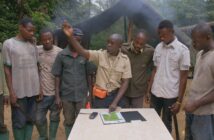In 1960, Jane Goodall transformed our understanding of what differentiates humans from the rest of the animal kingdom through the observation that chimpanzees make and use tools. This groundbreaking moment has been referenced time and time again, but what can we learn from Jane’s earliest findings and writings on the subject, and what we continue to discover today?
To set the stage, previous to Jane’s research, non-human animals were presumed to be functioning on an almost mechanical basis and their behavior was thought to be based on ‘preprogrammed’ instinct. In 1875 in his speech to the Royal Institution of Great Britain, Colonel A Lane Fox, President of the Anthropological Institute decreed:
“But who has ever seen any of the lower animals construct a tool and use it? The conception of man not as a tool using but as a tool-making animal is clear, defined, and unassailable . . . The ape employs both sticks and stones as missiles and as hammers to crack the shells of nuts. But we have no evidence that he ever selects special forms for special uses. It is this which so essentially distinguishes man from the lower creation. Man is the tool using animal. “
Who indeed! This was the prevailing belief – until Jane. In the Fall of 1960, everything changed.
November 6, 1960 – from Dr. Jane’s field notebook:
By the termite hill were two chimps, both male . . . I could see a little better the use of the piece of straw. It was held in the left hand, poked onto the ground, and then removed coated with termites. The straw was then raised to the mouth and the insects picked off with the lips, along the length of the straw, starting in the middle.
How exciting it is to read in Jane’s own words, her first clear observation of a chimpanzee using a tool to fish for termites. In 1964, Jane wrote a paper for Nature, detailing her observation over her first years in Gombe.


Can you imagine the thrill and excitement she felt as she saw these behaviors for the first time? This is one of the most significant moments in modern scientific history. Our belief that humans were the only species capable of manipulating objects and constructing tools came crumbling down and our eyes and minds were opened to the idea that we are not separate from, but connected to, the rest of the animal kingdom.
To me, maybe even more significant were the words she wrote a year earlier in a report for the Zoological Society of London. Believe it or not, in this earliest of papers, Jane was already developing a theory of non-human culture and the social transmission of behavior.


The above description is likely one of the first known instances in which the word culture was attributed to a non-human species. This was a completely new concept and these words were met with great criticism within the scientific community.
Jane continues to expand on these insights:
“There was thus opportunity for the attention of the infants to be directed to the tools and the way in which they were manipulated, and for them to learn their use by watching and imitation. It therefore seems probable that the use of sticks, stems and leaves for the specific purposes described here represents a series of primitive cultural traditions passed on from one generation to the next in the Gombe Stream area.
Through that visionary idea over 56 years ago, a new field of study was born. Today, generations of scientists are observing tool use and cultural variation in dozens of species all over the planet following in Jane’s footsteps. How fantastic it is that Jane started it all; and that we now see these beings, previously regarded as ‘lower creatures,’ as spectacular, feeling, thinking, conscious beings who have extraordinary mental and emotional capacity. How important it is to treat them with the respect and dignity which we ourselves expect.
Want to learn more about groundbreaking science and chimpanzees? Become a Gombe Science Hero today and support the longest running wild chimpanzee study in the world, started by Dr. Goodall continued by the Jane Goodall Institute!

The Jane Goodall Institute is a global community conservation organization that advances the vision and work of Dr. Jane Goodall. By protecting chimpanzees and inspiring people to conserve the natural world we all share, we improve the lives of people, animals and the environment. Everything is connected—everyone can make a difference.








